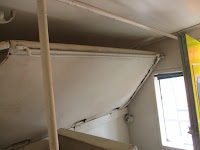Today the Milwaukee Road Historical Association paid a visit to IRM to dedicate their part of the MPB and to see all of the work that has been done on Milwaukee Road equipment. IRM has a large and varied selection of rolling stock from this road, and most of it was out for display.
The dynamometer really looks great.
The members of the association listened to speeches and got to see the interior of their new archives facility.
And Buzz has done a fantastic job over the past few days to clean up the interior of the X5001 caboose for people to ride in.
This is only a part of what was going on. I didn't get to see much of it, as I was busy with other things. The MRHA has been very cooperative and a great help to the Museum, and we look forward to a long and constructive relationship.
Now for the bad news. I replaced three of the headlight resistors in the box on the 319, but it still doesn't work. The top tube turned out to be defective, and I don't have any more spares available, so the headlight still doesn't work. So that was frustrating. I may be able to patch it up next time I'm out.
In any case, this would only be a temporary fix, and we still need to find a supply of new resistors. The wood cars are scheduled to operate next on the 28th and 29th, but only during the day, of course.











10 comments:
Randy,
Nichrome (pretty cheap before COVID) wire is readily available and it can be curled using a small lathe or even something rigged up with a crank - slow. Measure the OD of existing wire . That gives the gauge. Measure the ohms of a good resistor to get the length to curl. Western I believe has done a number of resistors. That is if the porcelain is OK
Dennis Bockus
Are there no modern power resistors that could replace the nichrome wound ones like these?
C Kronenwetter
A further question Randy. Are there any plans for cosmetic restoration of the Milw 265? It would be nice to pull Old Smokey out for display at a future MRHA meeting :)
C Kronenwetter
The nichrome alloy was patented in 1906. We found the coilwound heaters in the CA&E cars to use nearly pure nickel wire. The difference in resistance is substantial between nickel and nichrome, so an adjustment in gauge is necessary if changing alloys.
R. W. Schauer
Charles: They're not just plans, Gregg is currently working on repainting the 265. I have pictures of it at the bottom of the "Wednesday Workshop" post on Aug. 4th.
And these old nickel heater wires can become very brittle, which is why so many of them go bad. I'm no metallurgist, so all I know is that we need a 40 ohm resistor that will physically fit in the box and is rated for at least 600 watts. We're still looking.
I did elements for a Glass Kiln years ago, we used nichrome wire which we wound using a drill and a rod, made it long and cut it to length using a ohm meter.
It was easy as the new wire was fairly soft so it rolled nicely.
If you have the tubes, the main problem would be the adhesive to bond the wire to the tube.
-Hudson
That's interesting, it might be possible to do that ourselves with a little practice. We certainly have all the tubes we need, they don't go bad. The wire is not held to the tubes with adhesive, it's just a long coil spring wrapped around the helical grooves in the tube. There is also an asbestos string that runs through the element to help hold it in place. But those strings are weak and are mostly broken, and of course we don't want asbestos in there. I suppose that could be replaced with some newer heat-resistant material, although I don't know what to suggest.
A quick Google for 'fiberglass string' brings up a product rated at 600C. A quick Google for 'nichrome glows red at temperature' suggests that unless your resistors are red you'll be ok. The string might reduce any sagging/flexing. Drill a hole in the end of your forming rod and you could slide the coil right off on to the string.
Bill West
Thanks, Bill. And we have also gotten some good suggestions coming in via email from experts elsewhere. Now it would be a lot easier and probably more reliable if we could order some new resistors that would fit the requirements, but at least it looks like making our own should be possible.
Post a Comment